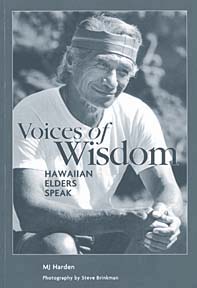


Hawaiian elders share
wisdom in ‘Voices’Voices of Wisdom: Hawaiian Elders Speak: By MJ Harden, with photos by Steve Brinkman (Aka Press); 239 pages; softcover; $24.95 By Nadine Kam
Features Editor
Star-BulletinI don't think navigator Nainoa Thompson could, chronologically speaking, be considered an "elder," but certainly the spirit and knowledge he possesses elevates him to revered status.
His is one of the profiles featured in "Voices of Wisdom: Hawaiian Elders Speak," a collection of 24 interviews by Maui-based writer MJ Harden.
The subjects represent a diverse group of Hawaiians, speaking of their lifestyle, work and traditions as they lived through this century, and their words are destined to become a two-way path for students of Hawaiian culture into the next.
Thompson, speaking of his 1980 voyage to Tahiti, his first trip as head navigator at age 25, describes his feelings upon entering the doldrums -- the area near the equator that is the cloudiest place on earth -- and being unable to navigate by stars, only by instinct.
"I did not want to go in. We saw it before we got to it -- 100 percent cloud cover, solid rain, no wind at all. The drops were just vertical. Wiping the rain off your face. It's still daylight."
In determining his direction, Thompson says, "I wasn't mature enough to tell the crew: I don't know. So I faked it and hid it, and I was trying to read the ocean waves in all this rain and in all this changing wind. I was a wreck. I was pacing around. I was getting very intense, looking for things you couldn't see.
"Mau (Piailug) was with me, but I couldn't talk to him. That was the agreement. I knew if he had to step in, it would have taken away from his success as a teacher."
Harden generally allows the subjects to tell their stories in long narrative passages. She is merely the guide who has led us to these people, and sets up and assists in the narrative transitions. In her bio, the writer says, "This is a book I tried not to write."
She said she came to the project with no agenda of what it is to be Hawaiian, having grown up in the Midwest. She moved to Maui in 1984 and found inspiration for the book in an art exhibition, "Faces of Hana," featuring portraits of Hawaiian elders.
Since the book's release, she said people have been reacting "as if I've rewritten the Bible. People are really inspired by it."
Others invited to speak were Dr. Kekuni Blaisdell, leimaker Marie McDonald, historian Herb Kane, kapa cloth maker Puanani Van Dorpe, genealogy expert Edith Kawelohea McKinzie, falsetto singer Kindy Sproat and chanter John Lake who speaks of the mana, or power, in words.
Lydia Namahana Mai'oho's tales of Mauna 'Ala, the Royal Mausoleum, were fascinating. As kahu, or caretaker, of the mausoleum that houses the bones of Hawaii's monarchs, she is descended from Ho'oulu, one of two brothers entrusted with hiding Kamehameha I's remains. They were chosen by the king, but how did he make his choice?
Mai'oho says, "What he did was to call all of his chiefs to see who he would pick. But only two of them came in their malo, and that was Ho'oulu and Hoapili. The rest came in their feather capes and helmets and stood before him. But he did not choose them."
Ultimately, he chose Ho'oulu and Hoapili because they did not take time to dress. "When he called them, they immediately came, and he knew that these were the two that he could trust to hide his bones secretly."
To this day, the location of his remains is unknown.
Sadly, Mai'oho and another of the book's subjects, minister and herbalist Kawika Ka'alakea, have already passed away.
The book makes it clear how important it is to preserve the personal stories of our elders for future generations.
Although names such as Thompson's and Blaisdell's are the stuff of daily newspaper stories, there is equal value in the traditions, practices and lifestyles of hundreds of everyday people, such as taro farmers and fishermen, that go largely undocumented.
Sections on Hawaiian healers, such as Margaret Machado and Lanakila Brandt, shed light on practices just beginning to become known outside the Hawaiian community.
The book contains far too few profiles to be considered a definitive work, but it succeeds if it inspires others to start collecting stories.
What's more, most of the book's subjects are still here to serve as resources for anyone who wants to know more.
Click for online
calendars and events.